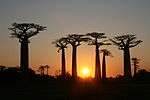Avenue of the Baobabs
The Avenue or Alley of the Baobabs is a prominent group of baobab trees lining the dirt road between Morondava and Belon'i Tsiribihina in the Menabe region in western Madagascar. Its striking landscape draws travelers from around the world, making it one of the most visited locations in the region. It has been a center of local conservation efforts, and was granted temporary protected status in July 2007 by the Ministry of Environment, Water and Forests, the first step toward making it Madagascar's first natural monument.[1]
Along the Avenue in some 260 m long segment are remaining some 20 - 25 trees[2] about 30 meters in height, of the species Adansonia grandidieri, endemic to Madagascar.[3] Some 20 - 25 more trees of this species grow in nearby rice paddies and meadows.
Baobab trees, up to 800 years old, known locally as renala (Malagasy for "mother of the forest"), are a legacy of the dense tropical forests that once thrived on Madagascar. The trees did not originally tower in isolation over the sere landscape of scrub but stood in dense forest. Over the years, as the country's population grew, the forests were cleared for agriculture, leaving only the baobab trees, which the locals preserved as much in respect as for their value as a food source and building material.[3]
Some 7 km further to the northwest are located the famous Baobab Amoureux - two Adansonia za trees twisted together.[4] According to the legend these two loving baobabs came and grew together across the centuries. Baobabs found themselves after an impossible love between a young man and young woman of the nearby village. However both had already an assigned partner and had to marry separately in their respective villages. However, the impossible couple dreamed of a common eternity life and having a child together and secretly asked help to their god. Both baobabs were born and now live they for eternity as one as the couple always wished.
The area is not a national park, and the trees are threatened by further deforestation, effluent from encroaching rice paddies and sugarcane plantations, and bush and forest fires.[5] Despite its popularity as a tourist destination, the area has no visitor center or gate fees, and local residents receive little income from tourism. Conservation International in partnership with Fanamby, a Malagasy NGO, has launched an ecotourism project aimed at conservation of the area and economic improvement for the local community.[6]
Additional images
| Local people on the Avenue |
|
References
External links




